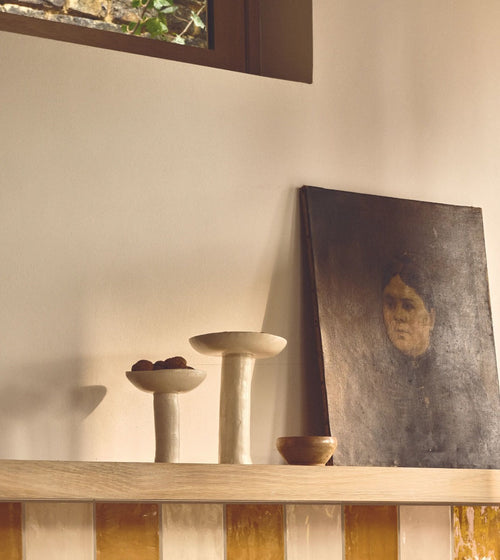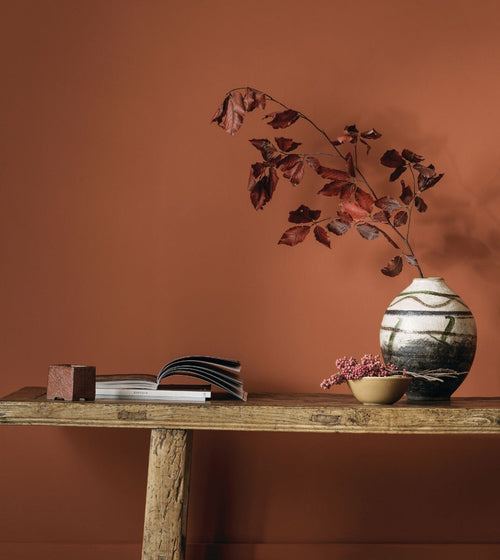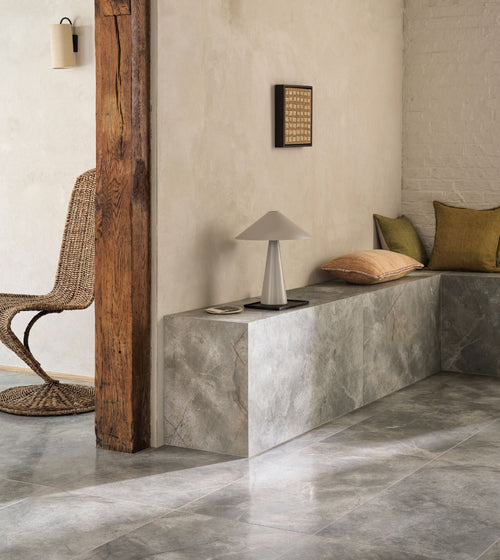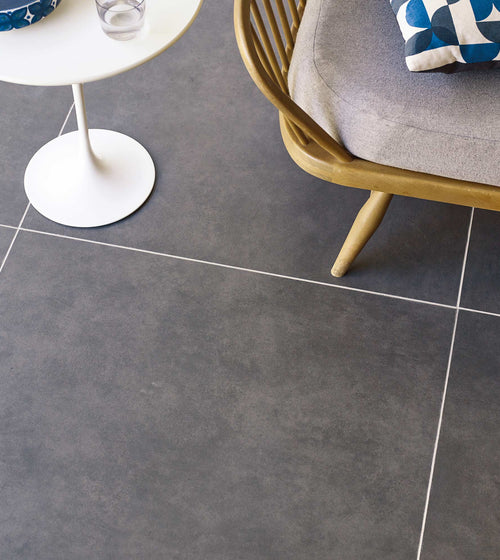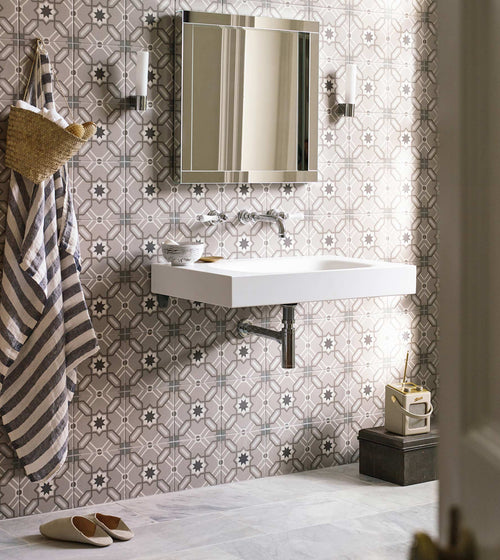The bathroom is often considered a sanctuary, a space where one can unwind and rejuvenate. Among the myriad decisions involved in bathroom design, choosing the right wall tiles can significantly impact the overall look and feel of the space.
In this guide, we'll explore why homeowners opt for tiled bathroom walls and the various options available to create different atmospheres. From practical considerations to design tips, we've got you covered.
Click on the link to jump to that section:
Compare the most popular bathroom tile materials for walls, such as porcelain and terracotta.
Find out the factors to consider when choosing a bathroom wall tile.
Browse through the most popular hues for bathroom wall tiles, and learn how to choose the perfect colour scheme.
Find out how to create unique layouts with different bathroom wall tile shapes.
Discover the benefits of using a bespoke service when planning a bathroom design.
Read the most common queries on bathroom wall tiles.
Tip 1) Choose the Right Material
Selecting an appropriate tile material ensures longevity and functionality in a bathroom environment. Here are some popular options, along with their benefits:
Porcelain
Renowned for their durability and water resistance, porcelain and ceramic tiles are ideal for bathroom walls. They come in a wide range of colours and patterns, offering versatility in design. Many porcelain ranges mimic other materials, such as natural stone, marble, and wood. These lookalike tiles are perfect for replicating classic bathroom looks alongside the long-lasting benefits of porcelain.
Other options for porcelain wall tiles include those that have a pattern or are brightly coloured.
Discover our entire range of porcelain wall tiles.
Terracotta
With warm, earthy tones, terracotta tiles add rustic charm to any bathroom wall. While they require sealing to prevent water absorption, the unique aesthetic of terracotta makes these tiles a popular choice for homeowners seeking a distinctive look for their bathroom. Consider using terracotta bathroom tiles behind a freestanding bath or as an accent wall.
Discover our entire range of terracotta bathroom tiles.
Stone
Natural stone tiles, such as slate, limestone or travertine, lend a timeless appeal to bathroom walls. Their textured surfaces add depth and character, although they may require regular maintenance to preserve their beauty.
Discover our entire range of stone bathroom tiles.
Though natural stone can add a sense of style, it is also susceptible to damage and chips. Consider a stone effect tile range, which offers a practical alternative and durable solution, particularly in a bathroom.
Marble
For a touch of luxury, marble tiles are hard to beat. They exude elegance and sophistication and elevate any room they use. At the same time, more porous than other options, proper sealing can enhance their durability and protect against moisture damage. With their individual veining, each marble tile is unique and exudes luxury - ideal particularly for a small bathroom as it can help maximise natural light and the look of more space.
Tip 2) Consider the Practicality
The bathroom is a unique environment within a home, frequently exposed to moisture and humidity. Therefore, the choice of tiles must be informed by their intended location and purpose. Factors such as slip resistance and moisture resistance should be prioritised, especially in family bathrooms.
Splashback
Tiles behind the sink or basin, known as splashbacks, do not face the same level of water exposure as shower walls but still need to resist splashes and humidity. Here, the focus is also on non-porous materials to prevent water absorption. Glass tiles are a popular choice for splashbacks as they provide a waterproof barrier and add a touch of elegance without sacrificing functionality.
Shower wall
Shower wall tiles must have excellent water resistance, as these areas are directly exposed to water daily. Consider choosing non-porous tiles, like a porcelain tile range, as they absorb minimal moisture, preventing the growth of mould and mildew.
Explore our range of shower wall tiles for practical yet stylish options.
Tip 3) Stand Out Colours vs. Neutral Shades
The colour scheme of your bathroom tiles sets the tone for the entire space. Consider the following pointers when choosing colours:
Family bathrooms benefit from bold yet simple colour schemes that are child friendly. As these bathrooms are often bigger, it makes sense to maximise the budget by choosing a material such as porcelain. Bright, light hues and reflective surfaces, such as glass, can visually expand smaller bathrooms lacking natural light.
Incorporate accent features with patterned tiles to create focal points and add visual interest. If you’re tiling a large space, you can stretch the budget by using more expensive materials in selected places, such as a splashback or shower wall, and less expensive tiles elsewhere in the room.
For more information, compare the most popular colour schemes for a bathroom wall.
Tip 4) Have a Creative Layout with Different Tile Shapes
Dare to be different with your tile layout by exploring unique shapes and patterns. Here are some ideas to spark your creativity:
-
Herringbone patterns offer a timeless elegance and are visually appealing.
-
Staggered brick layouts create a modern, dynamic aesthetic.
-
A mosaic tile layout allows for intricate designs and personalised touches.
Tip 5) Utilise a Bespoke Design Service
When designing a bathroom, it makes sense to get a little help from the experts. They may have solutions you haven’t considered and will be able to offer invaluable advice on layout and product choices. Our bespoke design service provides comprehensive support, including:
-
Full survey and measurement services - These are important as you want to make sure you get a room that looks great and is perfectly laid out, too.
-
Practical insights on tile quantity and layout.
-
Virtual styling with 3D visualisations and mood boards.
Book your design appointment with our experts.
Frequently Asked Questions
What is the difference between porcelain and ceramic?
Porcelain and ceramic tiles are both popular choices for tiling but differ primarily in their composition and water resistance. Ceramic tiles are made from natural clay, sand, and water fired at high temperatures. However, ceramic tiles are more porous than porcelain, making them less suitable for wet areas in a bathroom.
Porcelain tiles, on the other hand, are made from a more refined clay and fired at higher temperatures, resulting in a denser and more water-resistant tile. This makes porcelain tiles ideal for areas with high moisture exposure, such as a bathroom floor and shower wall.
What should you know about tiling a bathroom wall with larger tiles?
Tiling a bathroom wall with larger tiles can create a sleek, modern look and make a small bathroom feel larger due to fewer grout lines. Start by ensuring a clean, flat surface. Apply tile adhesive using a notched trowel, then press the tiles firmly into place, leaving even gaps for grouting.
Browse through our range of maintenance and fixing products, including tile grouts.
Related content
Comparing the Best Bathroom Wall Tile Effects | Buyer's Guide
